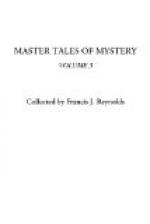Almost as he said it, the steel beneath the blowpipe became incandescent.
Just to test it, he cut off the head of a three-quarter-inch steel rivet—taking about a quarter of a minute to do it. It was evident, though, that that would not weaken the door appreciably, even if the rivets were all driven through. Still they gave a starting-point for the flame of the high-pressure acetylene torch.
It was a brilliant sight. The terrific heat from the first nozzle caused the metal to glow under the torch as if in an open-hearth furnace. From the second nozzle issued a stream of oxygen under which the hot metal of the door was completely consumed. The force of the blast as the compressed oxygen and acetylene were expelled carried a fine spray and the disintegrated metal visibly before it. And yet it was not a big hole that it made—scarcely an eighth of an inch wide, but clear and sharp as if a buzz saw were eating its way through a three-inch plank of white pine. With tense muscles Kennedy held this terrific engine of destruction and moved it as easily as if it had been a mere pencil of light. He was easily the calmest of us all as we crowded about him at a respectful distance.
“Acetylene, as you may know,” he hastily explained, never pausing for a moment in his work, “is composed of carbon and hydrogen. As it burns at the end of the nozzle it is broken into carbon and hydrogen—the carbon gives the high temperature, and the hydrogen forms a cone that protects the end of the blowpipe from being itself burnt up.”
“But isn’t it dangerous?” I asked, amazed at the skill with which he handled the blowpipe.
“Not particularly—when you know how to do it. In that tank is a porous asbestos packing saturated with acetone, under pressure. Thus I can carry acetylene safely, for it is dissolved, and the possibility of explosion is minimized. This mixing chamber by which I am holding the torch, where the oxygen and acetylene mix, is also designed in such a way as to prevent a flash-back. The best thing about this style of blowpipe is the ease with which it can be transported and the curious uses—like the present—to which it can be put.”
He paused a moment to test the door. All was silence on the other side. The door itself was as firm as ever.
“Huh!” exclaimed one of the detectives behind me, “these new-fangled things ain’t all they’re cracked up to be. Now if I was runnin’ this show, I’d dynamite that door to kingdom come.”
“And wreck the house and kill a few people,” I returned, hotly resenting the criticism of Kennedy. Kennedy affected not to hear.
“When I shut off the oxygen in this second jet,” he resumed as if nothing had been said, “you see the torch merely heats the steel. I can get a heat of approximately sixty-three hundred degrees Fahrenheit, and the flame will exert a pressure of fifty pounds to the square inch.”
“Wonderful!” exclaimed O’Connor, who had not heard the remark of his subordinate and was watching with undisguised admiration. “Kennedy, how did you ever think of such a thing?”




